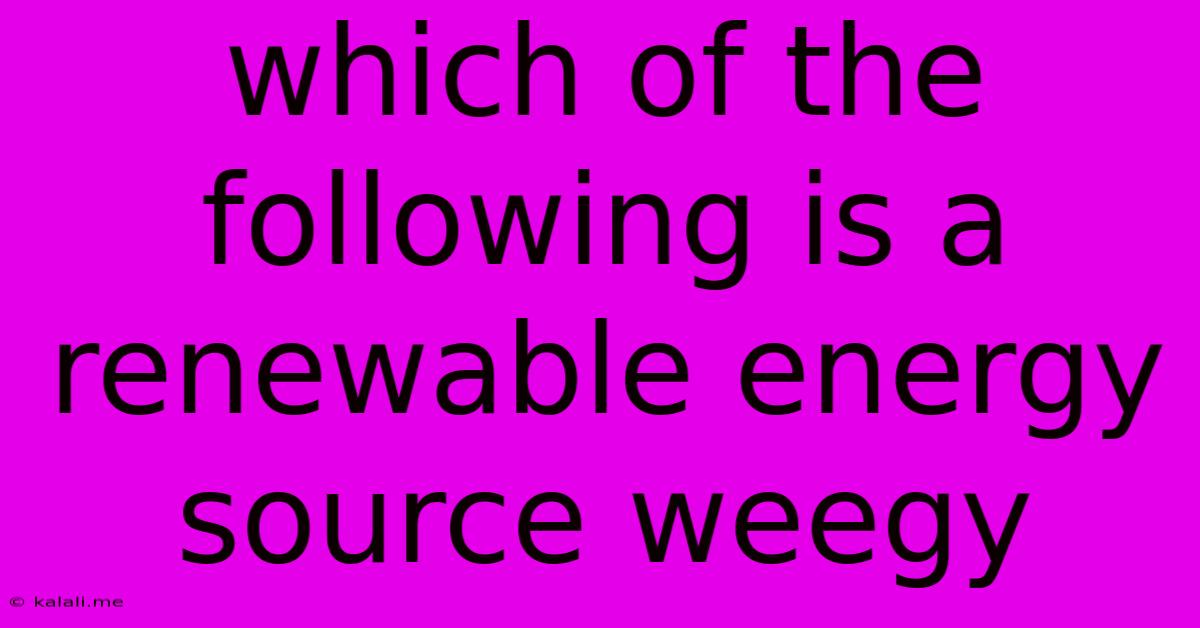Which Of The Following Is A Renewable Energy Source Weegy
Kalali
Jun 14, 2025 · 3 min read

Table of Contents
Which of the Following is a Renewable Energy Source? A Deep Dive into Sustainable Power
Choosing the right energy source is crucial for a sustainable future. This article explores renewable energy sources, addressing the question: "Which of the following is a renewable energy source?" We'll examine various options and clarify the characteristics that define renewable energy. This will equip you with a comprehensive understanding of sustainable power generation and its importance.
Renewable energy sources are naturally replenished over a relatively short period, unlike finite fossil fuels like coal, oil, and natural gas. Understanding the differences is crucial for making informed choices about energy consumption and supporting environmentally friendly practices.
Understanding Renewable Energy
Renewable energy harnesses resources that naturally replenish themselves. This means they won't run out, unlike fossil fuels which are finite resources. Key characteristics of renewable energy include:
- Sustainability: They are environmentally friendly and do not contribute significantly to greenhouse gas emissions or air pollution.
- Replenishability: The resources used are constantly renewed, ensuring a continuous energy supply.
- Reduced Environmental Impact: They minimize the negative effects on ecosystems and biodiversity compared to traditional energy sources.
Examples of Renewable Energy Sources
Many options fall under the umbrella of renewable energy. Some of the most common include:
- Solar Power: Harnessing the sun's energy using photovoltaic (PV) cells or concentrated solar power (CSP) systems. Solar energy is abundant and readily available in many regions.
- Wind Power: Utilizing wind turbines to convert kinetic energy from wind into electricity. Wind farms are a significant contributor to renewable energy generation, particularly in areas with consistent strong winds.
- Hydropower: Generating electricity using the power of moving water, often through dams and reservoirs. While a reliable source, it can have significant environmental impacts on river ecosystems.
- Geothermal Energy: Utilizing heat from the Earth's core to generate electricity or provide direct heating. Geothermal power plants are located in areas with significant geothermal activity.
- Biomass Energy: Burning organic matter like wood, crops, or agricultural waste to produce energy. While renewable, it can contribute to air pollution if not managed properly.
Differentiating Renewable and Non-Renewable Sources
The core distinction lies in replenishment. Renewable sources are constantly replenished, while non-renewable sources are finite and deplete over time. Non-renewable sources include:
- Fossil Fuels: Coal, oil, and natural gas, formed from ancient organic matter. Burning these fuels releases greenhouse gases, contributing to climate change.
- Nuclear Energy: While not emitting greenhouse gases during electricity generation, nuclear power relies on uranium, a finite resource, and poses risks related to nuclear waste disposal.
Choosing the Right Energy Source
The optimal renewable energy source depends on various factors, including geographical location, environmental considerations, and technological feasibility. For example, solar power thrives in sunny regions, while wind power is ideal in areas with consistent winds. A diversified approach, utilizing multiple renewable energy sources, often offers the most sustainable and reliable solution.
Conclusion
Renewable energy is vital for a sustainable future. Understanding the differences between renewable and non-renewable energy sources is crucial for informed decision-making. By embracing renewable energy options like solar, wind, hydro, geothermal, and biomass, we can reduce our reliance on finite resources and lessen our environmental impact. The best choice depends on individual circumstances and the specific context. However, the shift towards renewable energy is essential for a cleaner, healthier planet.
Latest Posts
Latest Posts
-
How Do You Turn Gas Into A Liquid
Jun 15, 2025
-
Where Is The Atmospheric Pressure The Greatest
Jun 15, 2025
-
A Poem That Has 14 Lines
Jun 15, 2025
-
University Of North Carolina Wilmington Gpa Requirements
Jun 15, 2025
-
90 Is 75 Of What Number
Jun 15, 2025
Related Post
Thank you for visiting our website which covers about Which Of The Following Is A Renewable Energy Source Weegy . We hope the information provided has been useful to you. Feel free to contact us if you have any questions or need further assistance. See you next time and don't miss to bookmark.